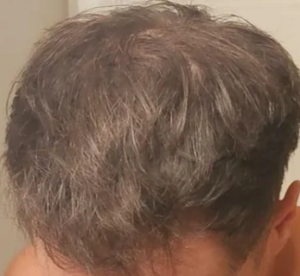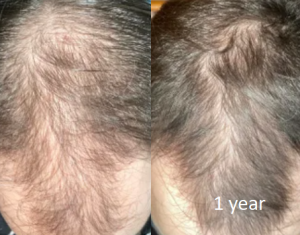1.5 years microneedling and finasteride (photo)
16 Year Old With Receding Temples Wants Dreadlocks
Hello, I’m 16 years old and I’ve been planning on getting my hair put into dreadlocks. I noticed my hair line near the temples were receding quite a bit. If I were to get my hair put into them would there be any negative effects?
Also, I had a blood test taken, and my doctor thinks that my baldness is down to my high testosterone levels and not much can be done for me, I told him about my real concern and I was told to take another blood test however focusing on different things. Is there anything that can be done to help regrow or prevent the baldness? I have been tempted to try certain products however I remain skeptical, what can you sugest?
- Dreadlocks may put extra tension on your hair and may accelerate hair loss or produce traction alopecia (hair loss from pulling and tension is common with dreadlocks).
- At 16 years old, your testosterone level should naturally be high.
- There are hundreds, if not thousands, of hair growth products out there. I am also a skeptic like you and I generally tell my patients that it is a “buyer beware†market. If you are concerned, have a good doctor map your hair for miniaturization and determine if you have early genetic hair loss and see if the doctor can predict the pattern of hair loss. I generally can do this in a young man at about the age of 25. Just remember that at your age, you are NOT a good hair transplant candidate and need to get the proper evaluation
2006-06-05 08:32:032006-06-02 07:16:2916 Year Old With Receding Temples Wants Dreadlocks
10 Months Since Chemo And Hair Has Still Not Fully Regrown
My son who is 21 completed a 4 cycle chemo treatment in May 05. Today his hair is still very thin, fine and spots of balding. I have left a message today with his doctor for some advise when I saw your web page. Any suggestions? I know hair growth takes a while but it is going on 10 months now. Thanks!
Hair loss during and after chemotherapy is one of the most distressing side effects. Hair loss occurs because chemotherapy targets all living cells in the body including hair follicle cells. Simply put, chemotherapy is poison to all living cells. It is a medical balancing game where the cancer cells are killed before the chemotherapy kills you.
Hair follicle cells have three phases of growth:
- Growth phase (Anagen phase) which lasts anywhere from 2 to 6 years. This is the phase where your hair is actively growing at approximately 10cm per year. 85% of hair is at this phase at any given time.
- Transitional phase (Catagen phase) which lasts about 2 weeks. This is the phase where the hair follicle shrinks and prepares to enter the resting phase.
- Resting phase (Telogen phase) which lasts about 1- 2 months. This is the phase where hair does not grow but stays attached to the follicle. Some hairs are shed at this phase, but at the end the hair follicle re-enters the growth phase to start the cycle over again. 10-15% of hairs are at this phase at any given time.
During chemotherapy, hair in the growth phase is most affected due to the active nature of the hair follicle. Ideally, hair lost during chemotherapy should start to grow after 3 to 6 months. Unfortunately, new hair may grow thinner, slower, or with different texture or color.
Your son’s hair growth seems to be returing, but at a much slower rate than you have anticipated. This may be due to the 4 cycles of chemotherapy. This may also be due to the fact that your son’s body is recovering at a different rate than expected. It may just be a normal recovery pace for your son. Ultimately, if your son is healthy and is in remission, that is the most important priority. Neverthess, hair loss is certainly the most visible and distressing side effect of chemotherapy and a stigmata of cancer. There are a number of support groups and wigs available to chemotherapy patients, which are sometimes even covered by insurance companies. Finally, topical creams or Propecia would not be of benefit for hair loss from chemotherapy.
By Dr. Jae Pak and Dr. William Rassman
[Note: This blog entry has been answered by Dr. Jae Pak, who has been working with Dr. Rassman for the past 9 years developing new surgical instruments and hair transplant procedures.]
2006-03-07 15:36:252006-03-07 23:04:4210 Months Since Chemo And Hair Has Still Not Fully Regrown
16 years old with great response to topical minoxidil (photo)
1 year on finasteride and minoxidil (photos)
15 y/o son lost forty pounds and half his hair. Doctor said his weight loss “triggered” mpb.
About this time last year my son lost forty pounds through diet and exercise. I started noticing some hair loss and we made an appointment. Primary doctor said it’s no big deal and the hair will come right back. Blood work came out fine. The hair loss started accelerating rapidly so we went to a dermatologist who said that the weight loss likely “triggered” male pattern baldness. She believes that he would have likely started losing his hair in five years or so, but the stress on his body kicked it into overdrive. She wanted to put him on finesteride (I said no), but he started minoxidil and some BS pills called Nutrafol. We went back to the derm three months later and hair was no longer shedding, but no regrowth. His hair is very diffused on top and even more so in the crown. I don’t know what to make of all this. I obviously don’t want him to go through this (it’s affecting his social life and anxiety), but putting him on fin seems dangerous. Is it possible to trigger male pattern balding or could this just be telogen effluvium?
Acute weight loss often causes hair loss and it can trigger MPB even in a 15 year old.
2019-06-18 04:03:522019-02-12 07:04:5515 y/o son lost forty pounds and half his hair. Doctor said his weight loss “triggered” mpb.
10 Months After My 5th Transplant, I’m Not Seeing Any New Growth
I had a transplant about 10 months ago. I can feel the stubbles since back then but it doesn’t seem to grow. It’s now 10 months later and it’s still the same. I had transplants before and almost very quickly, i would notice the thickening and darkening from the previous procedures.
This last procedure was my fifth and don’t seem to see a good result at 10 months. By this time my the transplanted hair should be maturing, correct? I now have about less than 3000 grafts done. Each procedure done in the past, the doctor could never extract enough donor. Perhaps it’s my donor area. Any thoughts?
At 10 months following your hair transplant, you should definitely see growth. Unless I am misreading your question, if you had five procedures that totaled under 3000 grafts, that is not today’s standard of care… however, I can not judge what your doctor was doing.
I’m not even sure what kind of surgery you had — strip or FUE. Plus, I don’t know if he was chasing your hair loss, if you were on finasteride, what your scalp laxity was, etc.
Have you talked to your surgeon about why there’s been no growth after 10 months? If you need a second opinion, you can either schedule a visit in my office or see another good doctor if I’m not local to you.
2014-02-06 14:01:442014-02-05 11:25:1510 Months After My 5th Transplant, I’m Not Seeing Any New Growth
Hair Loss Information – Balding Blog
Hi Doctor,
A lot of questions on here about initial shedding after a transplant, but my question is regarding transplanted hairs shedding years later, due to the natural hair growth process.
I noticed my transplanted areas have become thinner over the past couple of months. It has been almost 4 years since my surgery. It is well known that the hair growth cycle for hair is between 3-4 years, then they shed to make room for new hair. I was wondering since all transplanted hairs are relatively growing at the same rate or time period, should we expect periods of thinness every 3-4 years when these hairs are ready to shed again? In other words going through a shed similar to your first initial shed before the hairs started growing again. I hope my question makes sense.
Transplanted hair is permanent for most people. In the recipient area, the surrounding non-transplanted hairs may not be permanent and you will continue to lose those hairs. Years after a hair transplant you may be noticing the non-transplanted hairs falling. This is assuming there was non-transplanted hairs mixed in with the transplanted hairs.
If your hairs were transplanted on a completely bald area of your scalp and you are noticing shedding, this is not considered normal. It may regrow if you are experiencing telogen effluvium, which is a temporary hair loss that can occur at any time… or you could be one of those rare people who lose transplanted hair. I always look at the permanent zone when someone asks me about hair loss in the recipient area, in case they are losing donor area hair. Whatever happens to the donor area will happen to the recipient area. For example — in elderly folks, there is a condition called senile alopecia which reflects thinning of the hair throughout the head, including the donor area.
In a very rare instance, you may actually be experiencing permanent transplanted hair loss which I have seen possibly a dozen times in my 20+ years in practice. I don’t remember a cause of this to ever have been pinpointed in most of those patients and I wonder if I should be biopsying them when I see that problem, looking for diseases like diffuse alopecia areata.


